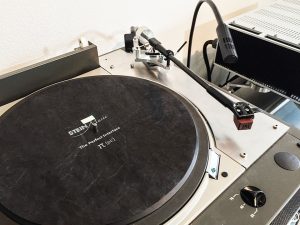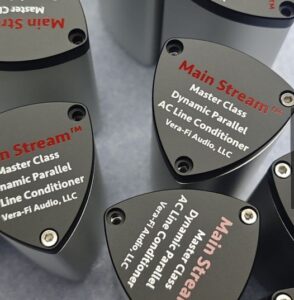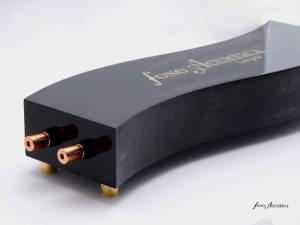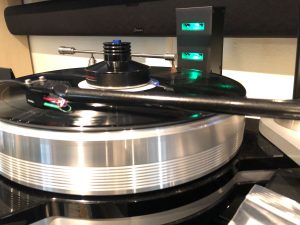Carbide Audio is based in the city of Llano located east of Austin, in the mountainous part of Texas. Founded in 2019 by Jeffrey Jenkins, this specialized audio company focuses on anti-vibration feet. It makes almost all the components for them in-house, using CNC machines, measurements and listening. We test its top-of-the-line Carbide Base Diamond model.
Carbide Audio company was established in 2019 and is based in Texas. As we read in materials sent to the editor, its owner, Jeffrey Jenkins, uses his small "but passionate team" and expertise in software engineering and machining to design, simulate, manufacture and test Carbide Audio products in his CNC workshop.
When saying "products," the company has one in mind, though it comes in three versions: the Carbide Base anti-vibration feet. Probably, sooner or later, more feet, perhaps smaller ones, and in the future anti-vibration tracks will enter the lineup. This is a natural development path that companies such as for example, Germany's Finite Elemente and Poland's Franc Audio Accessories have taken before.
I invoke these two companies for a reason. Both are based on rigid connections with a roller bearing in the lead role. It's a method of dampening vibrations that relies on the heat being lost by micro-movements of the ball in the bed. Another Polish manufacturer, Pro Audio Bono HERE, also has its version of this solution, and similar products are offered by Stacore HERE, Avatar Audio HERE or Divine Acoustics HERE, each in its own development. As it happens, all are Polish brand.
Products from Carbide Audio, whose name includes the name of the material most often chosen to make the aforementioned balls—carbide—also uses a bearing . But not only that, which distinguishes it from perhaps all other mature manufacturers on the market. In order to further separate the base and the place where the audio product is supported, it uses a lossy element in its design.
This, in turn, is a different method from rigid connections, represented, for example, by springs (Tewo Audio Spring, test HERE) or rubber, or specially selected spring materials (VinylSpot.pl all you need, test HERE). Which is the right one? This is impossible to determine unequivocally, it all depends on the specific application and on the expectations of the system owner.
Carbide Audio
Carbide Audio belongs to a group of manufacturers who base product development on measurements but correct the results with listening tests. Its first and, to date, only product, the Carbide Base footer, is a vibration isolator based on a patent-pending design. As he points out in the materials sent to the editors, it is a multi-axis isolator, meaning that it provides isolation in all six axes of motion.
This is the largest such product I have had in my audio system. I know there are equally large feet from other companies, but I haven't tested them until now. After all, even the large Divine Acoustics Galileo feet, on which the Ayon Audio CD-35 HF Edition player sits in the High Fidelity reference system, seem filigree next to the Carbide Base. Their designer, Jeffrey Jenkins, once asked by David Grzyb if it was possible to offer the same technology in a smaller form factor answered:
Indeed, the Carbide Base alloys are really big. We could have made them smaller, but that would have compromised their performance (sub. - ed). As the ViscoRing is made smaller and shorter, you begin to reduce the surface area that is free to bulge outward under compression which begins raising the resonance frequency. The ViscoRings are most optimally used near their maximum supporting weights and then their isolation performance is best.
As the ViscoRings become smaller, that "sweet spot" for their stiffness becomes narrower. The ability to have such good isolation performance over such broad weight ranges simply necessitated a larger size. Additionally, the inclusion of the separate lower stainless steel section with its zirconia ball bearings slightly raised the total height yet greatly improves horizontal isolation performance. These tiny spheres are roughly the same hardness as the more common alumina oxide ceramic ball bearings, but also over three times as tough so much less likely to fracture.
Dawid Grzyb, Carbide Audio Carbide Base. TEST, hifiknights.com, December 8th 2021, accessed February 16th 2024.
Carbide Base feet are extremely mechanically complex products. Maybe not as much as the aforementioned Divine Acoustics feet, but still. They are decoupled internally by both rolling bearings (balls) and a lossy element, the aforementioned ViscoRing. Because of the lossy material, it is necessary to adjust its susceptibility to the weight of the equipment or speakers you place on it. To facilitate this, a weight range has been color coded. We start as low as the lowest possible weight, and end at 317 kg (3/4 pc). The color of the chosen elastomer—green, gray, navy blue, red and black—can be seen in the cutouts in the main body.
A few simple words...
Jeffrey Jenkins, owner, designer
Jeffrey Jenkins in his workshop.
Carbide Base Footballs are a complex mechanical design that includes several layers isolating vibrations. (emph. ed). It is a multi-axis isolator meaning that it provides isolation in all 6 degrees of freedom. The lower stainless steel portion houses ball bearings which roll in hardened steel bearing raceways to provide horizontal isolation. Above it in a machined aluminum housing sits a large viscoelastic ring called the ViscoRing which is used to provide vertical isolation.
The ViscoRing is replaceable and is color coded according to stiffness so that the appropriate one can be chosen according to equipment weight. The 3 footers provided have the Gray "Light" ViscoRing installed which is ideal for small to medium components and loudspeakers. Attached are graphs showing the supported weights for each ViscoRing when using 3 or 4 footers.
The novelty of the footer centers around the shape of the ViscoRing and the housing it resides in. Unlike previous viscoelastic isolators which most commonly utilize thin or constrained layers of viscoelastic material, the ViscoRing is the opposite having tall and relatively thin walls. This is done to achieve a low natural resonance frequency which in turn provides good isolation of low frequencies. Here is more information on the design and utilization of the ViscoRing HERE.
The normal version of the footer described above is 360€ each. The version you have is the Diamond version which includes an additional ball bearing isolator in the top of the footer. This ball bearing isolator utilizes ceramic ball bearings which roll in extremely hard solid ceramic raceways which are coated in PVD Diamond. The hardness of the raceways helps resist indentation by the ball bearings. Achieving a maximally smooth, slippery, and indentation-free bearing surface allows for better filtering of very small amplitude and low frequency vibrations. JJ
And we already know that there is one product in the Carbide Audio lineup, it is available in several versions, both in terms of load capacity and protection level. We've already talked about the former, and the latter, in the text above, was mentioned by the designer himself.
In addition to the Base configuration, we can choose two more foot variants: Sapphire or Diamond. Both add an additional level of vibration dampening to the Base - a ball-based top bearing. The Diamond version uses ceramic ball bearings embedded in - as the designer said above—extremely hard Diamond PVD-coated solid ceramic raceways, which are slightly different in the Sapphire version. The Sapphire version also lacks the TwinDamp material, which is discussed below.
Interestingly, these are options that can be added in the future by swapping the Carbide Base for the Carbide Base Sapphire or Carbide Base Diamond. For the test we received the latter. The price difference is not small, as we pay 360 euros for the Carbide Base and 720 euros for the Carbide Base Diamond (both prices per unit). Subsequent installation of the Diamond insert costs 400 Euros.
As I said, one of the distinguishing features of the Diamond version is the use of TwinDamp material in the construction of the Carbide Base. As Mr. Jenkins wrote to us in an email, TwinDamp is based on a double-crystal high-damping manganese-copper alloy, which has more than ten times the damping capacity of pure copper. And further:
We then perform multiple stages of temperature treatments to further improve the damping performance. It (TwinDamp - ed.) has the damping capacity around that of rubber but in a rigid form and with a much wider effective bandwidth between 0.01 Hz and 10 MHz. The TwinDamp material is utilized above the bearing raceways in the Diamond insert to further damp vibrations passing through the footer. Here is more information on TwinDamp HERE.
When it comes to using footers, it is advisable to put them in place and then lower the component directly onto them. If possible, it is best if the footers can directly contact the bottom of the component. If the footers must be slid individually under the component, you may need to adjust their position after placement. The footer is most effective when the upper middle parts can move freely and are not in contact with the side wall of the body, so some adjustment may be required to make sure they are centered. The bottom part of the foot can be unscrewed to help level the component.
In the set we also receive spikes. If the feet are placed under the loudspeakers and you want to pierce thick carpet, screw them in from underneath. You can also screw the feet to the speakers or the device—in that case, contact the manufacturer or distributor to order the appropriate screws.
Unfortunately, I don't know anything about how the feet are packaged, as they arrived in "replacement packaging" for the test. But the communication with the outside world is on above average level in this company. On the manufacturer's website you will find detailed descriptions of all technologies, operations, etc. There are also measurements, and a detailed description of the construction, along with photos and graphics. Interestingly, among the several languages the website is available in is also Polish.
SOUND
HOW WE LISTENED
Carbide Audio's anti-vibration feet were tested in the High Fidelity reference system. I test all anti-vibration feet in my system in the same way—under the signal source, sometimes assisted by other devices. This time I tested them under the Ayon Audio CD-35 HF SACD player.
I'm moving the player during the test, so its connections must be flexible. I have Crystal Cable Absolute Dream interconnects in this role, and the player is powered by Harmonix X-DC350M2R Improved-Version cable. The comparison consisted of listening to the same piece of music (1-2 minutes long) on the reference feet and transferring it to the test feet. The player and the test feet stood on the top of a Finite Elemente Pagode Edition Mk II carbon rack top.
ALBUMS USED IN THE TEST a selection.
Stan Getz & João Gilberto, Getz/Gilberto, Verve/Lasting Impression Music LIM K2HD 036, K2HD Mastering, "24 Gold Direct-from-Master Edition UDM," Master CD-R (1964/2009).
Andrzej Kurylewicz Quintet Go Right, Polskie Nagrania "Muza"/Warner Music Poland 4648809, "Polish Jazz | vol. 0", Master CD-R (1963/2016); reviewed HERE.
Bill Evans Trio, Waltz For Debby, Riverside Records/Craft Recordings/Universal Classics & Jazz UCGO-9057, "Bill Evans Remaster Series," SHM-SACD (1961/2023); reviewed HERE.
Toto, IV, Columbia/Sony Music Labels SICP 10139~40 "Deluxe Edition. 40th Anniversary", SACD/CD 1982/2022; reviewed HERE.
Jean Michel Jarre, Oxygene, Disques Dreyfus/Mobile Fidelity Sound Lab UDCD 613, "Original Master Recording," Gold-CD (1976/1994).
Oh..., what a feeling it is when you sit down in front of an audio system, play an album you know and like, and then find that it sounds even better than before. It's moments like these that we live for, if I may say so, that we spend money and time for.
And that's exactly how I felt listening to the very first track using the Ayon Audio player placed on the Carbide Base Diamond. The procedure was simple; I listened to a piece of music with Player on the Franc Audio Accessories feet, the manufacturer equips the HF version of its players with and them replaced the latter with tested ones. The former are excellent, I am a fan of them and have used them exclusively for many years. However, they have their limitations, which were exceptionally clear compared to the tested feet. So I can't even imagine (of course I can, but it's a stylistic figure...) what it might sound like if I compared them with ordinary feet mounted as standard by audio companies.
What has changed, and what particularly struck me, is the deepening of the sound on the one hand, and its improved resolution on the other. João's voice from the Getz/Gilberto album, recorded with Stan Getz and released on CD-R ("24 Gold Direct-from-Master Edition UDM") by First Impression Music, was noticeably larger, more docile, and at the same time clearer.
This is exactly what I heard with the vocals of Gilberto's then-wife, Astrud in The Girl From Ipanema. As you know, she recorded her excerpts spontaneously, only because she accompanied her husband to the studio during the recording. You can hear them as if they were tacked on to the rest of the material, as they have a rather bright, dry tone, in contrast to the honeyed, silky sound of João's voice and the two main instruments—guitar and saxophone.
The American feet made the sound of the male vocals even more honey-smooth, even denser. But it was with Astrud that the change yielded the greatest benefits. Because now her voice was better anchored to the "base" of the recording, it was no longer so ethereal. It was still clear that it was something "extra," that these were co-opted fragments. But now it became much easier for me to understand why this was decided upon and what it gave. And what it gave was a breakdown of the rather uniform interpretation of the piece.
I heard an equally big change listening to Andrzej Kurylewicz Quintet's Go Right album in Jacek Gawlowski's 2016 remaster, burned for me on a CD-R disc straight from the "master" files. Here I heard more strongly, in turn, something that makes the sound with the Carbide Base denser and fuller. Without them, the presentation was thinner and leaner. Although—this is important—it seemed filled out enough to me without such a comparison. But you didn't have to sit in suspense to hear the changes I'm talking about, they were clear and unambiguous. And, most importantly, repeatable.
With American feet, both the leader's trumpet, played with a muffler, and Jan Ptaszyn Wróblewski's saxophone were more massive, more convincing in their timbre. It was as if they added a layer of meaning, or two. Interestingly, also the piano, in the title recording rather quiet and played pointillistically rather than legato, sounded clearer, stronger. Its timbre didn't change, it wasn't brighter, because that's also how better clarity can be achieved. But there was "more" of everything in the sound.
This is how high resolution manifests itself in practice. It's complementing the "image" with small elements, so that we stop "seeing" pixels and start perceiving it as a continuous, uninterrupted stream. Here it happens in a very good way, because at the same time the natural softness of the sound is preserved. That's why you could perfectly hear the tape sticking together in 3:14 of the aforementioned track on Kurylewicz's album, which is why the conversations "underneath" the sounds of Bill Evans' trio in My Foolish Heart from Bill Evans trio Waltz For Debby, released last year by Universal Music's Japanese division on the SHM-SACD disc, sounded clearer.
And it's not about something that interfered more with listening to music. On the contrary, it complemented it with information which in the case of Carbide Base Diamond anti-vibration feet was something absolutely positive, something good. Because the conversations in question, the clattering of cutlery against plates—remember that this is a live club recording—gave a stronger sense of participation in the event, led to a stronger identification with what I was hearing.
And part of this "immersion" into the world presented by the system with American feet under the player was the higher energy of the presentation. This will be, along with resolution and timbre, the third most important change they will bring to the sound. The opening kick drum and percussion in Africa, from Toto's IV album, gained vigor with them. The disc, listened to on the feet the Ayon is equipped with, sounds phenomenally good—and I'm talking about the SACD version, released by Sony's Japanese division in 2022 with a 7-inch cover. But it was the Carbide Base Diamond that made the presentation smoother, but also denser, more powerful, more energizing to the room.
Carbide Audio vs Divine Acoustics
It was incredibly interesting for me to compare the sound of the test feet with the ones I chose for my system, the Divine Acoustics Galileo. The feet are different in class, it's ultimately a completely different price range, but these are not differences like night and day. What I know from the Galileo, next to the sonic impact of the Pro Audio Bono feet, is the best that can be achieved at this time from products of this type and price.
As I say, Galileo and Carbide Base Diamond, both sets made changes of similar weight and value to the sound. And yet, each time I finished listening, I knew that the difference between the two was nevertheless important. The Polish feet sound in a slightly clearer way. They present the 1-4kHz range more clearly. The US feet are softer, creamier—you could say more "tube-like," to refer to that popular audiophile stereotype. It's a bit like slightly lowering the base of a turntable tonearm (Carbide Audio) or raising it a bit (Divine Acoustics).
Which version is better? I liked both very much. The advantage of the feet from America is their density and slightly lower mid-bass and mid-breakthrough, in, say, 200-300Hz range. This results in a larger scale of the events, a fuller picture. But the Galileo bring out even a bit more fine detail, without turning the whole presentation into highly detailed one. Carbide Base are rounder in their imaging, energizing the room more strongly. Their Polish counterparts do something similar, but with different methods, brightening up the treble a bit, but not by emphasizing it, but by giving more information.
However, after prolonged listening - longer even than the Carbide Base test itself—I came to the conclusion that the feet from the States have something that the Polish ones don't have, and thus no other feet I've listened to so far. It is about something like subliminal musicality. I'm reluctant to use the term, even though it has its operative value, and that's because it has been cruelly trivialized. But it is precisely in the case of the tested feet that it fulfills its role simply perfectly.
Summary
Carbide Base anti-vibration feet are a wonderful product. They are the best anti-vibration feet I have ever heard. Beautiful are their Polish competitors, both from Divine Acoustics and Pro Audio Bono, to name only the ones I use every day. But it's the American ones that go a step further with everything.
They add sophistication and depth to the sound, doing so through superb resolution. They energize the presentation by filling the space in front of us with a powerful, even firm, image. The soundstage is remarkably smooth and coherent with them, connective. But also the edges of the sounds are perfectly clear—only that they are not marked as a separate entity, they are part of the basic sound.
These are the feet for the best of the best systems. They will bring warmth, softness and fullness to them. And they will add a lot of energy in the bass, which will be useful for many systems. They do this without "boomy effect," because it's not about a filter-like effect, if I may say so, but about better filling this range with information. By the way, they are an outstanding audio product.
That's why we decided that they will stay in our system, two sets of them—under the Ayon Audio Spheris III preamplifier and under its power supply.
Price (when reviewed):
Basic version - 360 EUR/unit.
Diamond version (tested) - 720 EUR/piece.
Carbide Audio LCC
950 Watch Mountain Dr.
Llano, TX 78643-2090 ⸜ USA
MADE IN USA
Provided for the test by: DREAM AUDIO https://dreamaudio.sk
text by WOJCIECH PACUŁA
photos High Fidelity, Carbide Audio
















































